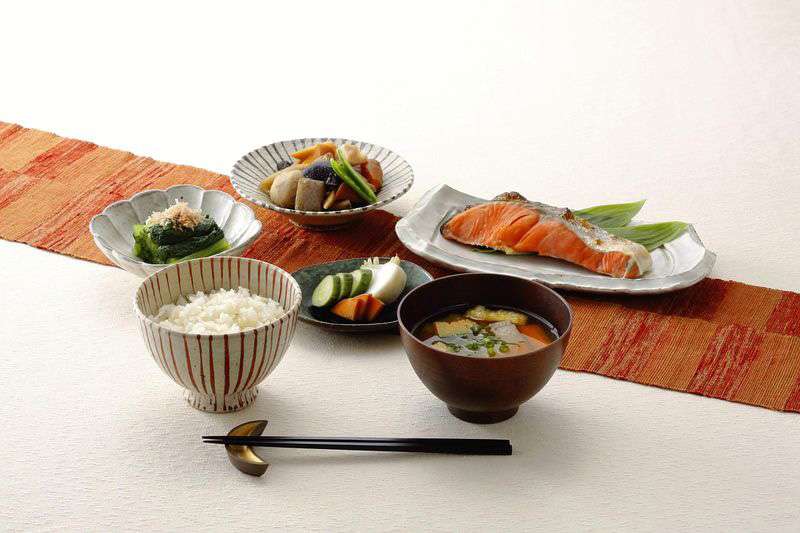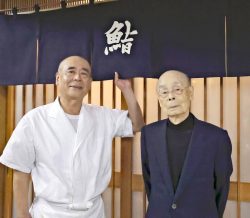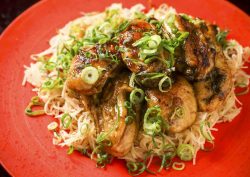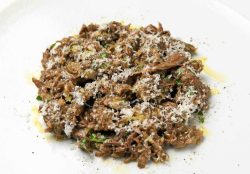
Japanese cookbooks that were translated into English
11:49 JST, February 8, 2022
Sushi, tempura and sukiyaki are not the only Japanese foods people crave overseas. People in Europe and other parts of Asia are now also hungering for foods eaten on a daily basis, such as onigiri rice balls, miso soup and tamagoyaki rolled omelets.
As people worldwide are increasingly exposed to these types of foods through Japanese TV shows, movies and manga, they can’t help but imagine how the foods might taste.
From screen to plate
The manga “What Did You Eat Yesterday?” features a middle-aged man who loves to cook at home. A live-action television series was aired in 2019, and a movie was released in 2021. The adaptations of the manga depict in detail the meals he makes for his live-in partner and his hunt to find inexpensive ingredients.

A typical washoku meal is served.
The series has been available for streaming since 2019 on Drama Korea, South Korea’s most popular website showing Japanese TV shows. A blog for the show posts the recipes of the food featured in each episode, including tamagoyaki; chicken and rice porridge; chicken wings and vegetable hot pot; and rice cooked with salmon and burdock root. Fans will then leave such comments as, “I’ll try cooking it myself,” and, “I’ll post it on a video-sharing site.”
In Asia, the Japanese film “Little Forest” received much attention. The film includes scenes featuring the main character eating meals she prepared using ingredients she grew in a mountain village in the Tohoku region.
After watching these scenes, many people developed an interest in Japanese home-cooked meals and started making such dishes as miso soup, norimaki sushi and oyako-don chicken and egg rice bowl, after referring to cookbooks and recipe-sharing websites.

In Turkey, many young people, mostly teenagers, are interested in onigiri because they saw it in the manga “One Piece.” In France, a cookbook has been published featuring dishes that have appeared in Studio Ghibli movies.
“Shinya Shokudo” (Midnight Diner) and “Solitary Gourmet” are also well-known overseas.
Use of media
About half a century ago, Japanese food could mainly be eaten only at restaurants.
The Yomiuri Shimbun published an article in November 1969 with the headline “Japanese gourmet paradise in New York,” describing Americans eating sushi and tempura at Japanese restaurants around Manhattan.
Japanese cuisine has continued to evolve worldwide, with the creation of such nontraditional dishes as California rolls, which use avocado.
With washoku traditional Japanese cuisine being added to UNESCO’s Intangible Cultural Heritage list in 2013, the number of Japanese restaurants overseas has increased from 55,000 in 2013 to 159,000 in 2021.
Many people still learn about Japanese culture through eating at Japanese restaurants. Lately, however, more people are being introduced through anime and other media.
“In recent years, even if the Japanese film, anime or TV show isn’t food-related, it will still contain many scenes showing people cooking and eating,” said Ryoko Sekiguchi, a translator and author living in France.
In these scenes, the works perfectly portray life and death, sickness, social disparity, separation, humor, friendship and growing older, Sekiguchi added.
The government also realizes the influence these forms of media have.
The Agriculture, Forestry and Fisheries Ministry has proposed in its policy guidelines that for five years, starting in fiscal 2021, scenes depicting people eating traditional Japanese meals be included in films and anime as a way to promote Japanese cuisine overseas.
Easy-to-follow cookbooks
In response to the enthusiasm for Japanese food overseas, Japanese publishers’ cookbooks have been translated into various languages and made available worldwide. As these books are designed to be easily read and understood, it has made them even more popular among fans.
A characteristic of Japanese cookbooks is that they include many photos and illustrations, not only of the finished product but of each step as well. By doing so, they help readers grasp techniques that would be difficult to convey through text alone, such as how to cut fish.
“European and American cookbooks put more emphasis on text and usually only include photos of the final result,” said Yuichi Kurakami, managing director of Charles E. Tuttle publishing company. “Japanese cookbooks are highly rated because the recipes can be easily followed just by looking at the pictures.”
"Features" POPULAR ARTICLE
-

Sanrio to Open Museum in Yamanashi Pref. Dedicated to Founder, Exhibits Include Hello Kitty, Other Characters
-

Legendary Sushi Chef Jiro Ono Turns 100: ‘I Have No Regrets’
-

Autumn Foliage Surrounds Visitors to Tokyo’s Showa Kinen Park
-

My Daughter No Longer Speaks to Me, But I Want to See Her and My Grandchild
-

Kumamoto: Public Bath Refurbished as Library Where You Can Chat, Take Photos
JN ACCESS RANKING
-

Keidanren Chairman Yoshinobu Tsutsui Visits Kashiwazaki-Kariwa Nuclear Power Plant; Inspects New Emergency Safety System
-

Imports of Rare Earths from China Facing Delays, May Be Caused by Deterioration of Japan-China Relations
-

University of Tokyo Professor Discusses Japanese Economic Security in Interview Ahead of Forum
-

Japan Pulls out of Vietnam Nuclear Project, Complicating Hanoi’s Power Plans
-

Govt Aims to Expand NISA Program Lineup, Abolish Age Restriction


























